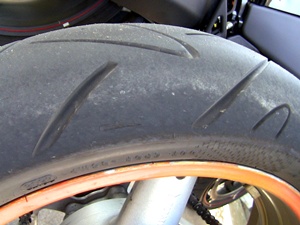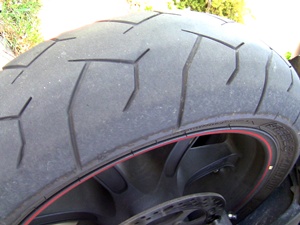| Author | Message | ||
Jion |
After seeing all the posts about various tires, I have a question that is more about the average Joe (read me). I also find the stock Corsa III's to be less than inspiring on the street. Even after about 30-40 miles on the freeway at 70mph before heading down a canyon, they are not all that sticky. So my question relates to how much "sticky" to how much "warm up"? Or, does all the sticky really happen at tire temperatures that mere mortals like me will never reach. Is the "sticky" curve flat (at say 20%) until the last 10% of tire temperature, then it goes vertical? I am definitely going to try a different set next time. I just replaced the rear tire at 4100 miles so it will be time for a full set just in time for cold weather. | ||
Drawkward |
I ran the stock Corsa III's on the track until they were showing cord. They have PLENTY of grip and only after about one lap...if that. What pressures are you running in the tires? | ||
D_adams |
Check your tire pressures, pre-ride and then again right before you get to your twisties section and once more once you get out of them. I forget the exact number, but it should be several pounds higher when you stop from a cold reading. If it's only a couple of lbs, then you are running too high initially for your pressure, maybe lower it a couple pounds. For me, street riding on BT-016's, I use 34/35 front and rear. On the track, it was 31 or 32 psi. It didn't make it a lot tougher to handle it at those pressures for track use, but it would make it wear a lot faster on the street. Btw, the BT's are lasting a lot longer on the street than the Corsa's ever did for me, by several thousand miles. I guess I'm seeing maybe 7000 or 7500 miles out of the rear, even more on the front. I've got one at over 10k miles now and still looks pretty good. | ||
Fast1075 |
Something is wrong, either the pressures or the suspension set up...I take my Corsa III to the edge. They have never let me down or did anything scary...unless I ran thru sand or oil or something...but no tire stays hooked up then... | ||
Jng1226 |
The first thing to do is to adjust suspension and tires to manufacturer recommended to get a baseline setting. If you still have low confidence feelings, perhaps it has something to do with the roads you ride. Do you have a lot of sealer, patchwork pavement or bumps on your roads? Summer weather usually provide significantly more grip because of the temperature of the pavement. Warming up tires is not just reaching the edge of the tire in a turn, but also applying smooth, hard acceleration and braking to create pressure increases inside the carcass. Some professionals will argue this brings a road tire up to operating temp more than any side-to-side weaving would do. Another factor is technique. Make sure you are smooth on the controls with all inputs. Smooth application of the brakes, smooth release of the brakes, smooth roll-on of the throttle before the apex, and above all smooth light pressure on the bars. All of the above will give you improved confidence and understanding of what's going on at the tire contact patches. On my standard street route, there is a smooth sweeping right-hand corner that is only 1.8 miles from my driveway. While I am still warming up the engine and tires, I regularly drag a knee on that corner because I know it well and am practicing the techniques I describe above. The point is, most modern sportbike tires, and especially the Corsa IIIs, have far more grip than you're likely to use, especially when warmed up. | ||
Gas |
It has been over 100 degrees here, and the tarmac is obviously much hotter than that. My Corsa IIIs are inspiring at these temperatures, but are very slow to warm during the winters and are never as warm to the touch as the Conti Road Attacks on my SV. The Contis warm up FAST and are a great tire in my opinion. Here are comparo pics. The Contis have 4200 miles, the Corsas 2600. As you can see, no track days and I don't ride too hard.   | ||
Drawkward |
Gas: That's interesting about the temperatures of the III's vs the Contis. Right off the track my III's were so hot I couldn't keep a hand on them for more than a few seconds. That's a lot more strain than regular commuting though. I'd say that the III's or the new Rosso Corsas that replace the III's aren't the best for commuting... | ||
Gas |
Yeah,Drawk, the track will warm up any tire if you are going fast. As you mention, commuting is a different ball game. In the land of gravel, soccer moms, chasing dogs, roofing nails, potholes,and winter morning commutes, part-time track tires are probably a second choice to a sport touring tire that will last twice as long and warm up QUICK. My feeling is, on the street you probably shouldn't use all the traction of ANY tire (except maybe the Moosiahaki DT Double Zero Kamakaze). But that's just my take, 'cause I'm afraid and cheap. | ||
Jaimec |
The only time I've ever had a problem with traction with the OEM tires is in the winter when I tried cornering too hard too soon. In Spring through the Fall, however, the tires warm up quickly and I never want for traction. If you want the tires to heat up quicker in the winter, drop the tire pressure by about 1 or 2 psi... but understand you will be increasing your tire wear significantly. | ||
Stirz007 |
+1 on previous comments: Corsas seem to work fine on the track when the ambient temperatures are above about 80. Seems like they take about a lap to get sticky enough to keep my lard butt upright. Jion - seems like you are providing adequate warm up. "lack of confidence" (?) - are you losing grip ?. I can take them to zero chicken strip, generate some decent tire boogers, and they seem to hold reasonably well. I do plan to try a non-pirelli as soon as I burn my current Corsa's up, though. | ||
Jdugger |
The Corsa III should be: 28-30 Rear 30-32 Front HOT off track, measured in hot pit lane They perform to almost novice race levels without warmers, in my experience. Really, it's an excellent tire for track day guys that haven't made the jump to race rubber and warmers. | ||
Drawkward |
Have to agree with JD...I love them. And will continue to purchase the Rosso Corsas. It's all about the pressure... | ||
Jion |
Well, that kinda explains the wiggly feeling that was the reason for my question. I am running 36-37psi rear and 34-35psi front. Great for riding to work, but not so good it seems when I hang a right onto the canyon. Will drop a couple-three psi and take a canyon run and see how it goes.  I would take a picture of my tire, but my chicken-strips are showing. | ||
Drawkward |
Jion:
Lol @ the chickenstrips statement. Let us know how the PSI change works out for you. | ||
Motorhead102482 |
Are you guys checking your tire pressure regurlarly, that complain about the grip of the Corsa IIIs? I check my tire pressure about once a week or if there is a drastic weather change, and I have to say I think they turn in pretty dang good. I also have never had them slip except for when they were brand new. In my first two minutes to work, I hit a traffic circle and give 9/10 of what she's got and I have no problems. I think some of you might not have your suspension settings set up for your body weight. Also a consideration, if you remove weight from the vehicle, for example you lose 15 lbs from the stock exhaust to an aftermarket one, you need to compensate for that in your suspension settings as well. In my personal experience, with the stock recommended suspension settings, and the recommended tire pressures, I think the stock tires handle great. |